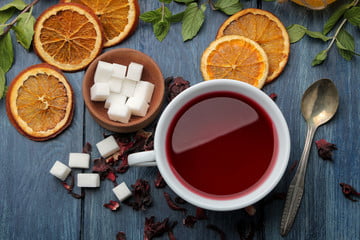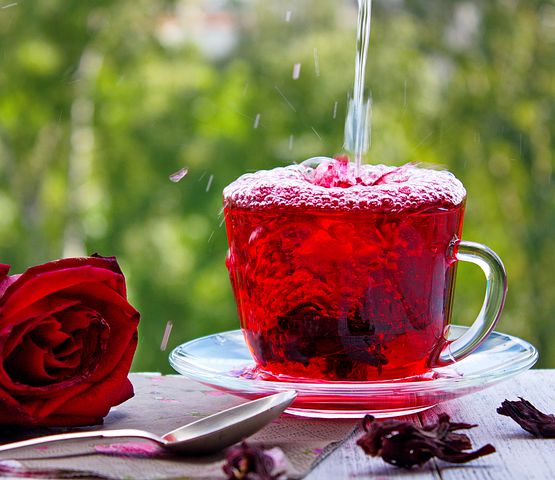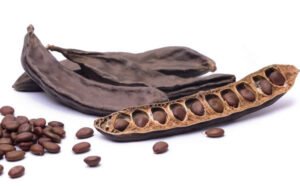Roselle also known as Hibiscus sabdariffa is a miracle plant with many health utilizations.
This wonder plant originated from West Africa, Nigeria, and belongs to the Malvaceae family.
Roselle is commonly called hibiscus tea worldwide, zobo, isapa, or ashuwe in Nigeria, guai shu in traditional Chinese medicine, belchanda in Nepal, sorrel in the Caribbean, and gonguru in India.
The entire plant parts made up of the seeds, calyx, fruits, leaves, and roots are all important to nutrition and health. However, the most popular is the calyx which is the outer whorl of the flower.
Roselle calyces could be red, green, or dark red. The red calyces are often used to make caffeine-free beverages and tea while the green-colored calyces are used as vegetables to make soup.
Different studies on roselle have confirmed that each plant part is rich in proteins, fats, vitamins, minerals, and antioxidants.
And these plant parts are effective in treating high blood pressure, cancer, and other metabolic disorders.
Nutrition Facts
Roselle is a unique plant. It contains high amount of vitamin C and calcium.
100 grams of raw calyces contains:
- Calories: 49 kilocalories
- Protein: 1.0 grams
- Carbohydrate: 11 g
- Fat: 0.6 g
- Minerals
- Calcium: 22% of Daily Value (DV)
- Phosphorus: 5% of DV
- Iron: 11% of DV
- Magnesium: 14% of DV
- Potassium: 4% of DV
- Sodium: 0% of DV
- Vitamins
- Thiamine (Vit. B1): 1% of DV
- Riboflavin (Vit B2): 2% of DV
- Niacin (Vit B3): 2% of DV
- Vitamin C: 14% of DV
- Vitamin A equiv.: 2% of DV
Note: Daily value is based on a normal 2000 calorie diet. Approximate values were given.
Uses of Roselle plant parts
The uses of roselle’s calyx, seeds, and leaves are as follows:
Roselle Calyx
The red fleshy calyx is the outer whorl of the flower and it is used in making fresh beverage drink, jam, jelly, syrup, gelatin, pudding, wine, cakes, ice-cream and is also brewed into tea.
The bright red color coupled with its rich taste makes it valuable in food products.
Another interesting fact is that the drink (Zobo) made from the calyces contains a rich amount of antioxidants and vitamin C.

Roselle Seeds
The seeds contain 17% – 21% oil and 20% protein. They are low in cholesterol and rich in phytosterols.
The seed oil is used to produce biodiesel, animal feed, paints, and sometimes, vegetable oil.
Since the seeds are high in protein, they can be roasted, ground into a powder, and used in soups and sauces. The roasted seeds can also be used as a coffee substitute.
Roselle Leaves
The young green leaves and tender stems of roselle are eaten raw in salads or added to soups.
They are also added to curries as seasoning because they have an acid, rhubarb-like flavor.
Health benefits of Roselle
Roselle has been used for many years in folk medicine. It is claimed to have a mild laxative effect, increase urination, give relief during hot weather, and treat cracks in the feet, sores, and wounds.
However, let’s check out this 10 scientifically proven health benefits:
1. Provides essential nutrients
The calyces provide most of the essential nutrients needed by the body in a low-calorie package.
Adding roselle calyx to your diet either in the form of tea or soft drink provides you with strong bones and a healthy immune system.
So start enjoying it today…
2. Lowers blood pressure
Several studies have shown that roselle extracts are effective in lowering blood pressure in both hypertensive and pre-hypertensive individuals.
One study revealed that aqueous extract of Roselle was as effective as captopril, an antihypertensive drug used in treating mild to moderate hypertension.
Although the exact mechanism of action was not investigated, the researchers concluded that daily consumption of Roselle extracts resulted in a decrease in both systolic and diastolic blood pressure.
3. Lowers cholesterol
High serum cholesterol is the cause of many metabolic disorders in the body.
According to a study conducted on hyper-cholesterolemic patients, two capsules of Roselle extract (1g), given three times a day (for a total of 3g/day), significantly lowered serum cholesterol.
Another study done among human subjects with and without metabolic syndrome showed that ethanolic extracts of Roselle significantly reduced low-density lipoproteins (LDL) and increased high-density lipoproteins (HDL).
4. Loaded with antioxidants

The hibiscus (Roselle) plant is rich in powerful antioxidants that help prevent damage and disease caused by the buildup of free radicals.
In one study in rats, hibiscus extract increased the number of antioxidant enzymes and reduced the harmful effects of free radicals by up to 92%.
5. Prevents cancer
This miracle plant is high in protocatechuic acid, a phenolic compound that has shown powerful anti-cancer properties.
In one test-tube study, hibiscus extract impaired cell growth and reduced the invasiveness of mouth and plasma cell cancers.
However, more human studies are needed to confirm the anti-cancer activity of hibiscus.
6. Prevents liver disease
The liver is a powerful organ that detoxifies toxins ingested into our body from our foods and drugs.
One research showed that extracts of calyces are rich in antioxidants. And that they help to protect enzymes that are responsible for detoxification in the liver.
7. Prevents common cold
The common cold is caused by viruses that attack us when our immune system is weak.
Hibiscus is rich in vitamin C and antioxidants that help to strengthen our immune systems and fight off the common cold.
Related: Natural remedies for cold and cough in children.
8. Prevents anemia
Anemia is a disease that can be caused by low iron levels in the blood. Iron is needed to produce hemoglobin, especially in pregnancy.
And interestingly, this wonder plant is a rich source of iron. So, pregnant women can take moderate amounts of hibiscus drink (Zobo).
However, the drink should not be taken in combination with pineapple, as an old myth says that pineapple could lead to miscarriages in early pregnancy.
9. Prevents microbial infection
Different studies have confirmed that hibiscus extracts are active against certain bacteria and fungi.
One study showed the antibacterial effect of hibiscus extract on Streptococcus mutans, a bacterium from the oral cavity.
In a similar study, the antibacterial potential of hibiscus was also observed on Campylobacter species.
10. Promotes weight loss
Studies have shown that roselle extracts is a potent inhibitor of pancreatic α-amylase.
An enzyme that is responsible for digesting carbohydrates and increasing blood glucose levels.
Therefore, it is possible that drinking a cup of hibiscus tea after meals can reduce the absorption of dietary carbohydrates and assist in weight loss.
Related: 50 African Foods to Lose Weight Quickly
Possible side effects
The Roselle plant is generally considered safe with few side effects.
However, excessive use of any of the plant parts may cause stomach upset, gas, headache, and nausea.
Similarly, while hibiscus tea may be a safe and natural way to help lower blood pressure, it is not recommended for those taking hydrochlorothiazide, a type of diuretic used to treat high blood pressure, as it may interact with the drug.
Most importantly, to avoid miscarriages in early pregnancy, it is best to avoid Zobo drinks that have been prepared with pineapple.
Recipes/Culinary uses
Hibiscus tea:
It is a healthy caffeine-free tea made from seeping dried calyces in hot water.
This tea can be sweetened with sugar and flavored with ginger or lemon.

Non-alcoholic beverage:
Soft drinks can be made with dried Roselle calyces.
To prepare, wash the dried calyces to remove dirt, then boil for 8-10 minutes to make a dark red solution.
The next step involves filtering the solution to remove calyces and adding sugar, pineapple, cloves, or ginger to sweeten and flavor.
Finally, allow the drink to chill in the refrigerator before serving.
Jam and jellies:
Roselle jam is made with only calyces and sugar. Because the calyces contain pectin and citric acid, the resulting jam or jelly is usually red, thick, and tangy.
To process roselle jam, collect and clean fresh calyces, then boil for 10-15 minutes. Finally, blend the boiled calyces and heat with sugar.
Well done, you have your ready jam to be preserved in jars.
Soup:
In Nigeria, a popular soup called Isapa or Ashuwe is prepared using fresh green roselle calyx.
It is prepared using oil melon seeds (egusi), beef, fish, vegetables, seasonings, and locust beans.
It is said to be very healthy and delicious.
The bottom line
Roselle is a healthy diverse plant with many utilizations. It is rich in antioxidants, minerals, and vitamins (B1, B2, B3, and C).
Antioxidants present in roselle calyces are good for our heart and health.
However, Roselle’s beverage and tea should be consumed in moderation to avoid unlikely side effects.
Get new free and exclusive health tips delivered straight to your inbox!



